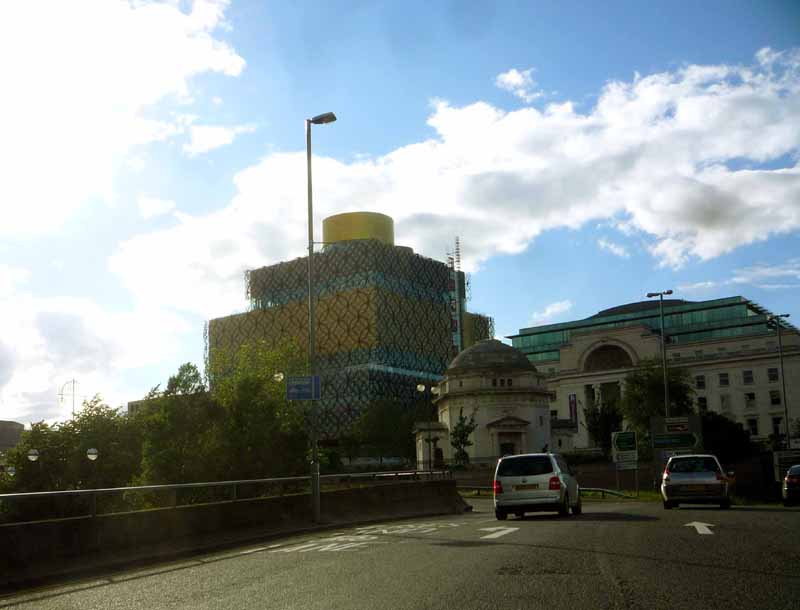Alan Clawley describes his visit to the newly-opened Library of Birmingham.
Amongst the gushing marketing language used to promote the Library of Birmingham one phrase struck me as odd until I went and had a look. We were told that the new library would have 400,000 books ‘on display’, double the number ‘on display’ in the Central Library. I thought this a curious use of language. I go to a library not to see a display of books. I suspected that I would see more books on open shelves to encourage me to ‘help myself’ without having to call on the services of a dwindling body of expert staff.
Now, having seen the celebrated Book Rotunda, the big architectural feature of the new building, I can see why the phrase ‘on display’ was used. The inside of the Rotunda is certainly lined with books, but they are not ones that the average user will want to take down to read. When I first saw photos of it I thought that the shelves had been stocked with IKEA-style cardboard replicas, they looked so uniform and unused. I began to wonder if the architects had had a hand in selecting and arranging them, not by the arcane Dewey Index, but by their colour and how they would look together. On closer inspection of the publicity photo I saw that the people thronging the Rotunda were not library-users choosing books but musicians playing trombones and other brass instruments at the official opening. The public does not have access to all the galleries.
The outside of the Rotunda is curious. There are bookcases, some of which are empty, but some of which are over the openings through which access is gained to parts of the inner Rotunda. The bottom shelves are about 3 metres above the floor, well out of reach of the tallest library-user or librarian. There aren’t any clues about how these hallowed tomes are accessed.
The primary architectural function of the Rotunda was to bring the much sought-after daylight from the roof through the hermetically-sealed archive stores on floors 5 and 6. Open light wells, or ‘atria’, inside big buildings are a common architectural device for doing this. Recently I visited the 10-storey Guinness visitor centre in Dublin that has an atrium in the shape of a gigantic pint glass. Madin’s Central Library has an atrium that is now seen as unfashionably square. The steel book galleries of the Rotunda however look like add-on features that gave the architect the opportunity to create a centrepiece and describe it as a ‘symbol of the power of books’. These galleries were not marked on the planning application drawings but neither were any bookcases elsewhere in the building. According to Francine Houben, when I met her in the corridor of the Council House after planning permission had just been granted, that was to be ‘the next stage of the design process’.
We may never know how many of the 400,000 books ‘on display’ are there just for show. Nevertheless it is reassuring for anyone who loves books to see them given pride of place, even if only in a symbolic way, in a 21st century library.
My previous articles on the new library were posted on the Press in 2011 when the designs were first seen. ‘Selling the New Library’ (April), ‘The Hole’ (September), ‘Rings of Aluminium’ (September) and ‘A library is not just a building’ (November)




The most important things in a library is to have the shelves of books with tables right there next to them. But instead this new improved concept has loads of books over there and tables right over there. This is severely impractical. By the time you’ve fetched your books someone has filched your coat and notebook and phone and pen and so on.
It’s rather clear that this building’s internal layout was designed by profit-obsessed tourism marketing consultants with not a grain of librarianship competence allowed to peek in. Hopefully something can be done to remedy this farce sooner rather than later. I don’t remember any consultation with library users – was there any?
And to access any of the piano (etc instruments) music books you now have to fiddle around with a complex of motorised stacks in contrast to the previous open shelves. And of course yet again there are no tables (or chairs) nearby!
I have a solution. Move all of the books etc back to the old Central library and convert the new one into a modern art gallery.
Excellent idea! The new building would make a good gallery of some sort, albeit the walls appear to be entirely glass. And could throw the tracey emin damien hirst etc trash off those terraces, creating a new genre of performance artwork in the process.